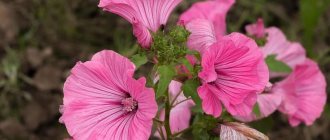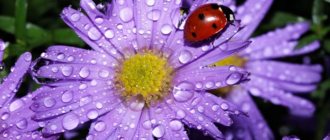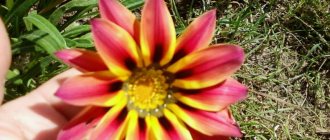Among the numerous genus of carnations, the Turkish carnation stands out: firstly, it is perhaps most often found in our flower beds, and secondly, it is a biennial. Strictly speaking, in nature this variety grows as a perennial, but due to the cool climate in the central zone of our country, it is cultivated as a biennial.
The plant is incredibly popular - in almost every garden you can find multi-colored inflorescences of Turkish carnation. This is not surprising: its small but bright flowers are very attractive and perfectly decorate flower beds. In addition, despite its short lifespan, the culture is very unpretentious and easily propagated. In addition, Turkish cloves exude a wonderful aroma and are an excellent honey plant that attracts bees.
But this is not all the advantages of this wonderful plant. Its flowers are edible, and its petals have a pleasant sweet taste. Also, Turkish cloves are considered medicinal, although official science has not yet confirmed this fact. However, despite the many beneficial properties, Turkish cloves are most often used in ornamental gardening.
The plant began to be cultivated in the 14th century, and the first mention of it is found in the works of the English botanist and naturalist John Gerard.
The Russian name of the species indicates the homeland of the culture: in its natural environment, the flower can most often be found in Southern Europe and the Middle East. Additionally, wild Turkish cloves grow in northeastern China as well as southeastern Russia. Well, garden varieties can be found all over the world, they are especially popular in regions with temperate climates. Natural varieties of the plant are usually colored red and white; cultivated Turkish carnations have a variety of shades - pink, purple, lilac, white, red, etc. Selection has also worked on the shape of the flower - double and semi-double inflorescences are often found, and the height of the varieties may vary.
The English name of the Turkish carnation is interesting: in Great Britain the flower is called Sweet William. There are several versions of the origin of the unusual nickname. According to one legend, the plant is named after the famous 18th-century military leader William Augustus, Duke of Cumberland, and according to another, in honor of William Shakespeare. Other famous people with the same name are also mentioned - William the Conqueror and St. William of York. According to another, more prosaic version, the word “william” is similar to the French “oeillet”, which translates as “clove”. The British are very fond of this flower: it often appears in folklore romantic ballads and was even included in the bride's bouquet during the wedding of Prince William and Kate Middleton.
In our country, this species is sometimes called the bearded carnation because of the large number of thread-like bracts that look like a beard around the flower.
Botany classifies the Turkish carnation (lat. Dianthus barbatus) to the numerous genus of carnations (lat. Dianthus) of the clove family (lat. Caryophyllaceae). This is a medium-tall (20-60 cm in height) herbaceous plant with strong erect shoots, narrow elongated (1-2 cm in length, 4-10 cm in width) green or silver-green leaves and dense corymbose inflorescences consisting of individual flowers of various coloring. The diameter of one flower varies from 2 to 3 cm, and the diameter of the entire inflorescence is about 10-15 cm. Usually a flower consists of five petals, but flowers of double and semi-double forms can contain up to ten petals. After flowering, a capsule fruit with a large number of flat black seeds is formed.
What does Turkish clove look like?
Turkish carnation is a perennial herbaceous plant, grown in gardening as a biennial. It has straight, knotty shoots from 20 to 75 cm high, covered with oppositely sessile lanceolate-shaped leaves. They have a green or bluish color with a red tint. During flowering, fragrant flowers with a diameter of 1.5-3 cm, simple five-petaled, or having varying degrees of terry, appear on the bushes. The colors of these carnations are quite varied and include shades of white, cream, pink and red, and the velvety petals usually have a jagged edge. The flowers are collected in corymic inflorescences up to 12 cm in diameter. Turkish carnation forms them only in the second year of cultivation, towards the end of June. During the first year, the plant forms only a leaf rosette. It is noteworthy that the flowers of such carnations are edible. After flowering, boxes with black seeds appear on the bushes. They ripen by August and can be used to propagate carnations. Seed germination lasts about 3-5 years.
Turkish carnation attracts gardeners not only with its beautiful flowers, but also with its undemanding nature in terms of growing conditions and easy care compared to its relatives. It can tolerate semi-shaded places and also withstands frosty winters well.
“Undeservedly forgotten” – Turkish carnation (bearded)
Where is the best place to plant barbatus?
Barbatus prefers light, non-acidic soils rich in nutrients. It is cold and frost resistant.
Requires good drainage and does not tolerate stagnant water.
Unlike other types of carnations, it is undemanding to light and can bloom in partial shade, but in shade the flowering is less abundant.
The plant is a perennial; in cultivation it is bred as a biennial - in the first year it forms a rosette of leaves, in the second - flowers.
Brief rules for growing Turkish cloves
The table provides brief rules for growing Turkish cloves in open ground.
| Landing | Sowing of seedlings is carried out closer to the beginning of April, the seedlings are transferred to the ground from mid-May. From the end of spring, you can sow cloves directly into the garden bed; in mid-autumn, winter sowing can be done. |
| Lighting level | These plants require full sun. |
| Watering mode | The flowers are watered twice a week, spending up to 15 liters of water per 1 square meter. m. In hot weather and drought, watering is carried out more often. |
| The soil | Turkish cloves prefer fertile loams or sandy loam soils. |
| Feeding | Carnations are fertilized 3 times during the summer: when the height of the seedlings reaches 10 cm, with the appearance of buds and during the flowering period. Both organic and mineral compositions are suitable. |
| Bloom | Flowering occurs in mid-summer. |
| Trimming | When the carnation fades, you can cut off its flower stalks. |
| Reproduction | Seeds (seedlings or direct sowing), less often - cuttings or layering. |
| Pests | Mole crickets and earwigs sucking insects. |
| Diseases | Fungal or viral diseases. |
Reproduction
Growing Turkish cloves from seeds is not at all difficult if you follow the rules. In addition to propagation by seed, there are other methods:
- Reproduction by layering. To do this, press the flower stem you like to the ground, attaching it with wire (after cutting off the inflorescence). The branch is sprinkled with moist soil. After two weeks, the cuttings will take root, and a month later the first leaves will appear, the flower will be dug up and transplanted to a new area. They usually begin propagation by layering in late July and early August.
- Garden carnations reproduce well from cuttings. Cut the stems of a two-year-old plant and plant it in moist soil. After about 21 days, the young seedling will acquire its first green leaves. In the last week of August it is replanted; the fragrant inflorescences will delight you with a riot of colors the following summer. Growing using this method, but in a greenhouse, will speed up the rooting process.
Important! Carnations can propagate by self-sowing, but the varietal characteristics are lost.
Growing Turkish cloves from seeds
Sowing time for seedlings
If Turkish cloves are grown through seedlings, you can start sowing in the first half of spring. To do this, you will need nutritious but fairly light soil, for example, a mixture of sand or vermiculite with leaf humus. The substrate is disinfected and then poured into clean pots or containers. A drainage layer should be laid at the bottom of the planting container.
The clove seeds are buried by about 1 cm, maintaining a distance of 2-3 cm between them. The crops are covered with translucent white paper on top. Before emergence, the containers are kept in a moderately warm (about 16-18 degrees) room and the soil is kept constantly moist. Shoots should appear within 2 weeks.
Seedling care
When the sprouts appear, they are transferred to the brightest place, slightly lowering the temperature so that the seedlings do not stretch out. Turkish carnation is light-loving, so additional lighting can be used for it. With the appearance of the second pair of true leaves, the seedlings are planted in ordinary or peat pots with a substrate of the same composition as when sowing. After picking, the seedlings will only need systematic watering and careful loosening. To make the bush more lush, at the stage of 5-7 pairs of leaves, you can pinch the cloves.
The seedlings can be moved outside towards the end of May, when the frosts will probably subside. Only a few varieties of Turkish carnation bloom in the year of sowing, so the planting period does not affect the flowering period - the main thing is to have time to plant the plant in a permanent place before August. Before planting, it is recommended to harden the seedlings by moving them into the air every day and gradually increasing the time they spend outside the house. Usually, seedlings begin to be hardened a couple of weeks before transplanting.
What or who can threaten plants
In general, cloves are highly resistant to many diseases. However, dampness and wet soil can provoke the occurrence of diseases such as fusarium (or root rot) and heterosporiosis. In both cases, the affected plants must be immediately removed from the site, and the soil must be disinfected using fungicides. It is advisable not to grow Turkish cloves in this place for at least 2-3 years.
Among the pests in flower beds with carnations you can find spider mites and aphids, which suck all the nutritious juices from the plant. If you find insects on flowers, take immediate control measures. You can use insecticides or resort to folk remedies.
In spring, young, tender shoots of carnations are attacked by rodents. After their invasion, it is almost impossible to save flowers. Therefore, take care of the cloves prematurely. Place poison or rodent traps around the plants.
Important! Carnation is one of the few flowers that can be given to both women and men.
The author of the video will tell you about the rules for planting Turkish cloves for seedlings.
Sowing Turkish cloves in open ground
When to sow
Turkish cloves can be sown directly in the garden. In this case, sowing begins only after stable warm weather has established itself - at the very end of spring or beginning of summer. You can sow cloves before winter - in October. For winter sowing, only dry seeds are used, and the soil must also be dry. A bed with cloves is mulched for the winter with a layer of sawdust or peat, removing the cover only next spring.
How to plant correctly
Turkish carnation. Sowing. Care. Flowering.
Although the Turkish carnation is considered shade-tolerant, it will require ample sun to bloom profusely. To plant carnations, choose a well-lit place with nutritious sandy or loamy soil. A couple of weeks before planting, you need to dig it up with a shovel, at the same time adding the necessary nutrients: compost or humus (about 7 kg per 1 sq. m) and wood ash (about 250 g per 1 sq. m). You can also use mineral supplements - about 1 tbsp. spoon of nitrophoska and 1 teaspoon of universal flower fertilizers per 1 sq. m beds. The dug up bed is left under the film until planting. By the time of sowing, it is removed and furrows up to 1.5 cm deep are made on the soil surface. 15 cm are left between rows. The finished furrows are watered, and then the seeds are placed in them, maintaining a distance of about 3 cm. The crops are covered with a thin layer of soil and lightly compacted , and before sprouts form, cover with non-woven material.
When planting Turkish carnation seedlings in a flowerbed, the bushes should not be buried too deep into the ground - their root collars are left on the surface. Between bushes they maintain about 15-25 cm, depending on the size of the variety.
Caring for Turkish Carnation
Watering
In order for the Turkish carnation to delight with abundant flowering, it will need a sufficient amount of moisture. The bushes should be watered approximately twice a week, using up to 1.5 buckets of water per 1 square meter. m beds. In dry and hot weather, watering is carried out more often. It is advisable to direct the water not to the leaves, but to the roots of the plants, so they will definitely not get sunburn.
When watering cloves, it is important to remember in moderation. This flower tolerates dry periods well and will withstand a lack of moisture better than waterlogging. Bushes planted in shade or low areas will not need water as much, and overwatering can cause root rot in such plants. If the bush begins to shed its leaves, it should be treated with a fungicide solution (for example, XOM in a proportion of 40 g per 10 liters of water). By autumn, watering the carnation is reduced, moistening the soil only during drought.
Feeding
In addition to watering, Turkish cloves will need to be fed. The first time flowers are fertilized at the seedling stage, when the height of the seedlings is about 10-12 cm. To do this, you can use a solution of nitrophoska (1 tablespoon) and Agricola Forward or another similar product (1 teaspoon) per 10 liters of water. The second feeding is carried out at the beginning of budding; for this, 1 tbsp is dissolved in 10 liters of water. a spoonful of potassium sulfate and superphosphate. During the flowering period, you can use any fertilizer for flowering species. In autumn, you can fertilize plants only with potassium and phosphorus.











